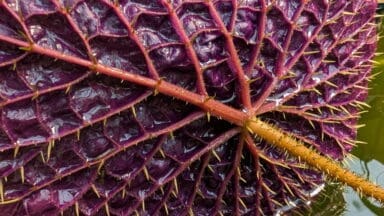
Inspired by his passion for tropical plants, Chris Bowers transformed his 100 m2, derelict, “dated Essex Patio” into a mini, vibrant, biodiverse tropical rainforest, boasting several hundred tropical (hardy and tender) plants, trees and ‘swamp’ ponds. The Pocket Rainforest garden is now a vibrant ecosystem, alive with rare insects, slow worms, pond-loving aquatic creatures and birds – even kingfishers.
Bowers opens the Pocket Rainforest to raise money for the World Wide Fund for Nature (WWF), a charity close to his heart. Aware that unusual, jaw dropping plants encourage donations and help to raise awareness of the plight of rainforests, Bowers set his sights on growing one of the most impressive aquatic tropical plants, the giant waterlily, Victoria Amazonica, from seed.
The second largest amongst Nymphaeaceae family, Victoria amazonica is native to tropical South America, it was first discovered in Bolivia in 1801 and named Eurgale amazonica, but was subsequently moved to a new genus named in honour of Queen Victoria. In South America, it grows in the backwaters of rivers in the Amazon basin, the Guianas and the Pantanal.
Famous for their incredible platters, the leaves of these mighty plants can grow up to a diameter of around 3 metres and can hold the weight of an adult. Highly engineered, the leaves are constructed from a network of radiating ribs and cross-veins on their underside, which as they grow and expand, create rigid compartments that both trap pockets of air and distribute weight across the entire surface. The upturned rims help keep water off the leaf, whilst its large size and sharp spines underneath prevent other plants from encroaching.
Bowers first saw the waterlily’s in Kew’s Waterlily House, which was originally built in 1852 to house their famous collection. Highly prized as an ornamental, V. Amazonica is known to have very particular requirements for successful cultivation but undeterred, Bowers was determined to grow the lily for his Pocket Rainforest in Kent.
“Since a child I’ve always been fascinated by tropical plants and the sheer size they can put on in just one growing season. Having grown them for many years now, I’m no stranger to the huge leaves that can be achieved if kept in the right conditions. Having also kept koi and tropical fish for a lot of years, I was no stranger to aquatic plants and their needs….or so I thought,” said Bowers.
Breaking the surface
In his research, it became apparent that cultivating them in a domestic environment is near to impossible and presents a significant challenge, far exceeding anything the experienced tropical gardener had ever grown before. Finding viable seed was the first hurdle, but searching far and wide, Bowers managed to source viable seed from a private seller.
Germinating Victoria Amazonica, requires warm, sterile conditions, maintained to 28–32°C (82–90°F) in a heated water-tank to maintain the temperature. Seeds are sown in a soil mixture or directly in water, but the key is to keep the environment consistent to encourage germination, which can take several weeks.
After extensive research, Bowers commenced the challenging process. He sowed the seed directly in water, using a sterilised water tank, heated to 28°C and equipped with a full-spectrum grow light positioned above the water’s surface. Every day, the water was changed to prevent bacteria causing mould or contaminating the precious seed.
“On day 9, to my amazement a shoot began to show from just one of the seeds. I was absolutely over the moon. In a few days a second seed began to show signs of germination. Unfortunately the other seeds didn’t show any signs or healthy germination, and developed a mould like substance around the seed casings, so they were quickly removed from the tank.
The two seeds were developing, but for reasons unknown, one started to develop the same mould the others had succumbed to. “I was gutted and started to question if the last seed would end the same way as the other five and that would be my chance of growing this seemingly impossible plant over and done. I made sure to continue the sterile water changes and trust the process,” he explained.
It paid off. “Eventually the seed produced its first ‘blade of grass’ looking leaf. I still find it amusing how an absolute giant of a plant produces such a different, almost irrelevant first leaf to what the mature plant is capable of, but I knew I was on the right path,” explained Bowers passionately.
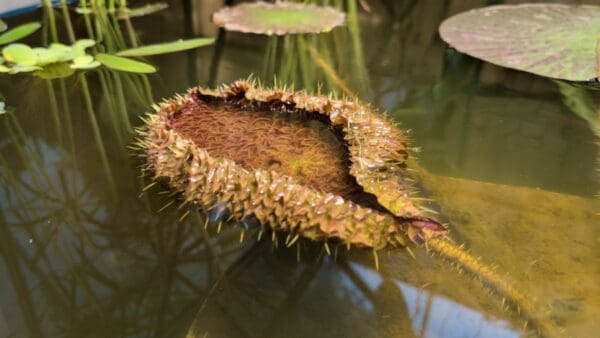
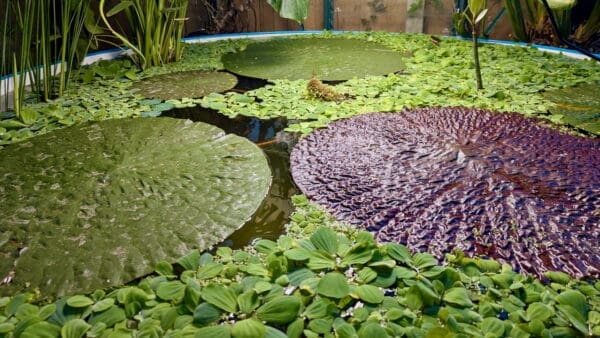
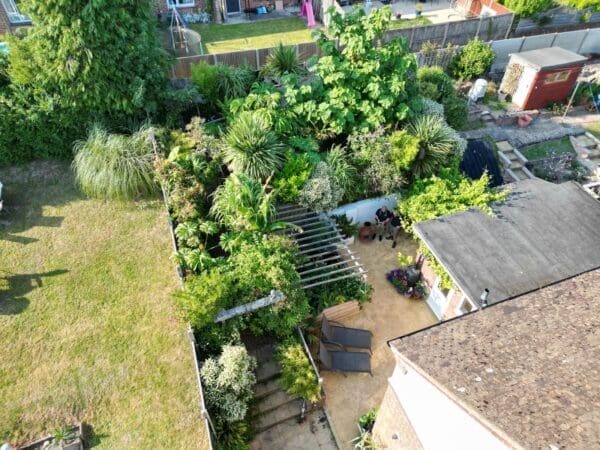
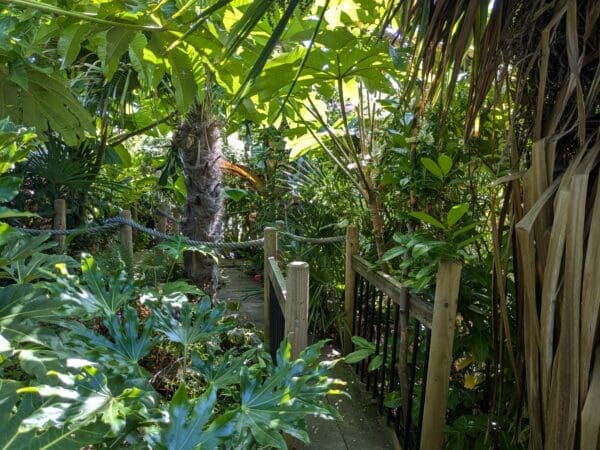
Slowly but surely signs of roots appeared, and his new plant was soon ready to be potted on into sterile compost to begin its journey to maturity. Bowers explained that as the days and weeks went on, the leaves gradually developed from “a tiny dagger shape”, to the more familiar, round lily pad shape, armed with characteristic spines along the stem and on the underside of the leaves.
“As the plant sized up, so did the heated water tanks. I began to pot it up into larger pots with more and more feed as the plant grew,” he said.
Using a mixture of aquatic compost, topsoil and a generous amount of chicken manure pellets, Bowers’ magical lily started to grow. So much so, that after a few months, the plant outgrew the nursery tank and was moved into its new home, a heated pond in a glasshouse Bowers built specifically to house his newly grown treasure.
Proudly, Bowers tells us that the leaves now measuring almost one meter in diameter. According to the tropical gardener, he may be only private collector to have grown a V. Amazonica at home, which considering the effort taken to grow it isn’t surprising.
He’s far from finished though. “It’s been an absolute pleasure to grow this spiky giant and I hope to source some more liable seed again this November and start the process all over again,” said Bower. Who knows, next year Kent may have an entry, or even a few, in the annual Waterlily Weigh-Off competition….
Bowers’ V. Amazonica can be admired on his next open day, which takes place on the 20th of September. Details to follow on Pocket Rainforest Project.

